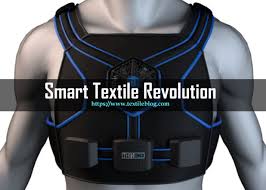“Weaving the Future: The Convergence of Smart Textiles, Sustainable Innovations, and Wearable Technology”**
Greetings, fab textile aficionados and curious tech enthusiasts! Today’s topic takes us on an enlightening journey through the constantly evolving universe of textile news, where we’ll delve into apparel breakthroughs, ready-made garment trends, and sensational fashion waves. If you’re passionate about the fusion of traditional textiles with innovative technology, stick around, because we’re about to unweave an interesting tapestry of insights and revelations.
The Smart Textiles Revolution: Where Fashion Meets Function
Smart textiles, the harbingers of a futuristic fabric revolution, have been making significant strides in the textile and apparel sectors. But what exactly are smart textiles? Also known as e-textiles or electronic textiles, these are fabrics embedded with digital components such as microcontrollers, sensors, and actuators. Imagine wearing a shirt that changes color based on your mood or a health-monitoring vest that sends real-time data to your smartphone. These aren’t just figments of sci-fi imagination but realities emerging from advanced textile engineering.

One key term in understanding smart textiles is “conductive yarns,” which are essential in creating functional, interactive garments. Conductive yarns are threads infused or coated with conductive materials like silver, nickel, or carbon. These yarns can then conduct electrical signals, making them integral to sensing and interacting with various elements, from body temperature to environmental conditions.
From Concept to Consumer: The Journey of Smart Textiles
The path from a smart textile concept to a finished product involves several intricate stages. The initial phase focuses on material selection, where the choice of base fabric — like cotton, polyester, or nylon — plays a crucial role. The selected fabric should be durable, flexible, and comfortable while capable of integrating electronic components seamlessly.
Once the base fabric is selected, the next step involves embedding the smart elements. This could mean weaving conductive yarns directly into the fabric or attaching flexible printed circuit boards to it. These processes ensure that the final textile maintains its look and feel as a traditional fabric while acquiring additional functionalities. For instance, imagine the complexity of creating a flexible display fabric that an athlete can wear to monitor their performance metrics in real time, without feeling the burden of extra gadgets.
The Rise of Wearable Technology in Apparel
Wearable technology has woven itself deeply into the fabric of modern fashion, creating garments that are as intelligent as they are stylish. Shoes with GPS navigation, shirts with built-in heart rate monitors, and jackets with climate control features are no longer a fantasy. This integration of tech into textiles is revolutionizing how we understand clothing, morphing it from a mere style statement to a multifunctional tool.
One fascinating aspect of wearable technology is the development of “energy-harvesting fabrics.” These fabrics can generate electricity from movements or the environment. For example, piezoelectric materials embedded in a fabric can convert mechanical stress from body movements into electrical energy, potentially powering small devices like fitness trackers or LEDs.
Major Trends in the Ready-Made Garment (RMG) Sector
The Ready-Made Garment (RMG) industry is a rapidly evolving landscape, continually adapting to consumer demands and technological advancements. The RMG sector is particularly notable for its quick turnaround times, making it a bellwether for fashion trends. One major trend within the RMG sector is the increasing emphasis on sustainable practices. Consumers today are more conscious of the environmental impact of their clothing choices, leading to a surge in demand for eco-friendly garments.
Sustainable textiles, often referred to as “eco-textiles,” involve using organic or recycled materials, eco-friendly dyeing processes, and innovative waste management. An excellent example is the use of “recycled polyester,” derived from recycled plastic bottles. This process not only reduces waste but also lowers the carbon footprint compared to traditional polyester production.
Technical Textiles: Beyond Fashion and Function
While fashion and everyday wear often grab the spotlight, technical textiles silently play a pivotal role in various industries. Technical textiles, also known as industrial textiles, are specially designed for functional purposes rather than aesthetic ones. They cater to a myriad of applications, including medical textiles like wound dressings and bandages, automotive textiles used in airbags and seat belts, and even agro-textiles for crop protection.
One groundbreaking application of technical textiles is in the field of “geo-textiles.” These are permeable fabrics used in civil engineering projects, such as road construction, to enhance soil stability and drainage. They help prevent erosion, improve soil structure, and are vital in constructing embankments, retaining walls, and even landfills.
The Intersection of Fashion and Technology: Future Possibilities
Looking ahead, the intersection of fashion and technology promises a plethora of exciting possibilities. Imagine fabrics that could repair themselves when torn, or garments that monitor pollutants in the air and change their composition to neutralize them. Such visionary ideas are already in the research and development pipelines, signaling a future where textiles and technology are indistinguishably intertwined.
One intriguing concept being explored is “programmable textiles.” These involve fabrics embedded with nanotechnology that can alter their properties on demand. For example, a single garment that can change its permeability, color, or texture based on environmental conditions or user preferences. This would not only personalize fashion to an unprecedented level but also make it multi-functional, reducing the need for multiple clothing items.
Challenges in the Smart Textile Sector
Despite the rapid advancements, the smart textile sector faces several challenges that need addressing. One major hurdle is the integration of electronic components without compromising the textile’s core qualities of comfort, flexibility, and durability. Ensuring that the electronic parts withstand regular wear, washing, and environmental exposure is critical for consumer acceptance.
Additionally, the cost of producing smart textiles remains relatively high compared to traditional fabrics. As with all emergent technologies, economies of scale and further research and development will be essential to bring prices down, making these innovative garments more accessible to a broader audience.
A Sustainable Vision: Marrying Ecology with Innovation
Sustainability remains a guiding ethos in the contemporary textile industry, pushing for eco-conscious innovations at every stage of textile production. The amalgamation of sustainability with smart textiles is fostering groundbreaking solutions, such as biodegradable electronic components and photochromic dyes that reduce the need for chemical treatments.
Another fascinating development is the use of “biosynthetic fibers,” which involve engineering fibers at the microbial level. For instance, companies are now exploring the production of fibers from algae or bacteria, which can be more sustainable than traditional farming and harvesting of natural fibers like cotton. Such biosynthetic fibers could also be engineered to include electronic functionalities, further blending the boundaries between biology, technology, and fashion.
Concluding Threads: The Ever-Evolving Textile Landscape
In wrapping up this intricate journey through the realms of textile innovation, it’s clear that the future of textiles is as thrilling as it is uncertain. From smart textiles that integrate seamlessly into our daily lives to technical textiles that support critical industries, the possibilities are boundless. As technology continues to advance, the textiles of tomorrow will not only cater to functionality but also prioritize sustainability, facilitating a more harmonious coexistence between technology and nature.
So, whether you’re a fashion enthusiast, a tech geek, or an eco-warrior, the textile industry’s future holds something remarkable for everyone. Stay tuned to Textile Topher’s blog as we continue to explore the marvelous world where fabric and innovation weave the stories of tomorrow. Until next time, keep weaving your dreams and threading your thoughts through the fabric of creativity!
Keywords: Smart textiles, Conductive yarns, Wearable technology, (Post number: 184), Technical textiles, Sustainable textiles





